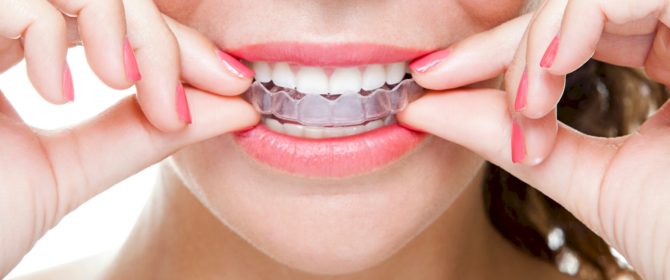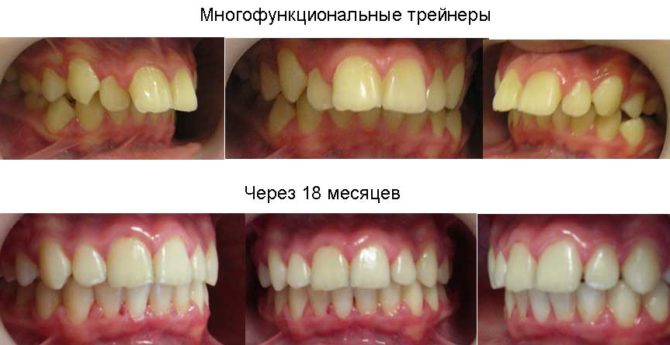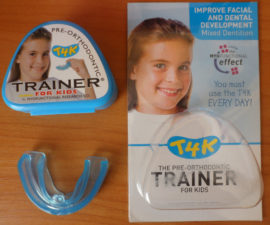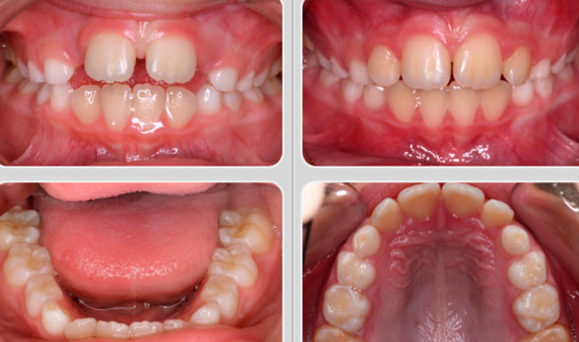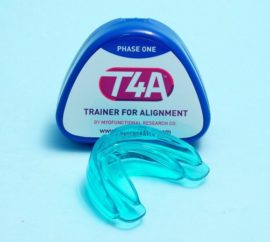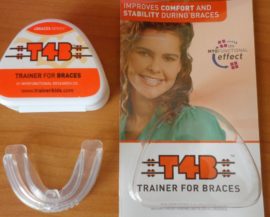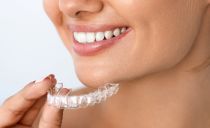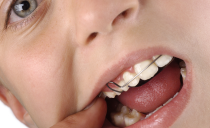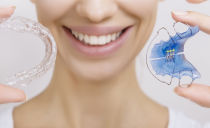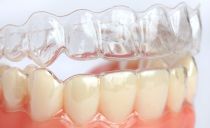Children's and adult dental trainers: varieties, indications, wearing rules, cost
Adults and children dental trainers are unique devices for correcting the occlusion and aligning the dentition. Elastopositioner allows you to quickly and painlessly remove dental defects in patients of any age.
Content
The structure of simulators for aligning teeth
The first dental trainers were invented just over 20 years ago by the Australian company Myofunctional Research Co. Exercise machines are made of polyurethane and silicone, are soft (blue or blue) and hard (red or pink).
Externally, they are mouth guards for the upper and lower jaw, which consist of:
- recesses for teeth;
- labial bumper;
- labial arch;
- internal delimiter for language;
- marker tongue.
Trainers have a universal shape, so when installing them, you do not need to take additional impressions and spend time on the production of an individual apparatus. Devices correct the bite gradually and almost imperceptibly.
Indications
Elastopositioners get rid of bad habits: wean children to suck their fingers, bite their nails, grit their teeth. But most often they are used in orthodontics for the treatment of a variety of dental pathologies. These include:
- crowding of teeth, characteristic of the period of change of milk molars to molars;
- deep bite, accompanied by improper closing of the teeth;
- speech defects;
- wide interdental fissures;
- mouth breathing in a child;
- curvature of incisors and fangs;
- an abnormal bite (when closed, half of the upper and half of the lower rows overlap).
A dental trainer is used instead of a bracket system to correct dental defects if a person is allergic to metal.
Contraindications
The trainer can not be used to correct occlusion in adults, adolescents and children if they have the following pathologies:
- immunodeficiencies of varying severity;
- oncological neoplasms;
- incomplete adentia (absence of more than 4 crowns in the dentition);
- heart and blood diseases;
- weak bone healing;
- endocrine pathologies;
- tuberculosis;
- HIV
Classification
There are several types of structures for aligning the dentition:
- articular - to restore the functionality of the temporomandibular joint and to eliminate pain in the jaw muscles;
- for braces - do not allow the system to damage the gums;
- Finishing - set after removing braces to consolidate the result;
- sports - are used to protect teeth when practicing dangerous sports;
- children's - are shown with milk teeth;
- adults - help to cope with dental defects of permanent teeth without installing bracket systems.
T4A Trainers for Adults
These designs allow you to cure serious orthodontic diseases in the age category of patients who, for whatever reason, are inappropriate to put braces. But T4A trainers can only be used if minor malocclusion is diagnosed. The severity of the pathology is determined only by orthodontists and dentists.
The treatment regimen for malocclusion in adults looks something like this:
- 2 trainers are acquired:
- flexible (blue) for delicate pathology correction;
- hard (pink), which has a greater power effect on the dentition, for complete correction;
- blue is set at night and sometimes for several hours during the day;
- pink is set at the final stage of correction and only in the daytime, at night, patients continue to use the blue design.
The success of the procedure depends on the desire of the patient himself, since no one checks the correctness of their use of elastopositioners - the orthodontist gives only general recommendations.
Trainers for children
There are several types of trainers for children, which are selected taking into account the structural features of the dentition and age of the child.
T4k
There are two main types of T4K trainers: initial and final. Initial preorthodontic trainers can be used for dental straightening of primary teeth, so they are shown even to preschoolers.
Benefits of the initial T4K Trainer for correcting malocclusion in children:
- does not cause discomfort and gag reflex;
- easy to install: even the child himself can fix the product in the oral cavity;
- it is allowed to use with a stuffy nose, course treatment does not need to be interrupted even with the development of inflammatory diseases.
Estimated time of application of the initial trainer for malocclusion in young children is 8 months.
The final trainer is more rigid and looks like an orthodontic arch of braces. The principle of its use is similar to the initial application, but it must be worn longer: up to 12 months. The average market value of T4K is 3 thousand 500 rubles.
T4a
T4A constructs are used to correct defects in adults and in children over 10 years old. The principle of the trainer’s action is the constant effect of the labial arches on the teeth, which leads to a gradual straightening of the bite and a decrease in the tone of the mandibular muscles.
The wearing time for trainers depends on the type of pathology that needs to be fixed. Usually they range from 3 to 9 months. The device should be worn daily. Construction prices start at 3 thousand 500 rubles.
Advantages of the T4A Orthodontic Trainer:
- it should be worn mainly at night;
- during the day the structure can be worn for only 1-2 hours;
- with the correct position, the mouthpiece quickly takes the form of a jaw;
- The trainer is easy to care for.
Bracket Trainer T4B
T4B is a bracket trainer. It intensively affects the dentition and enhances the effect of using the bracket system. Such designs should be worn overnight or for several hours during the day.
Typically, the effect of using the T4B trainer and braces is visible after a few weeks, but the course period of the full correction is from 6 to 12 months. The cost of the trainer will be at least 3 thousand 700 rubles.
Finishing orthodontic trainer for teeth
After braces are removed, the dentition requires additional adjustment and support. So that the teeth do not return to their original position, it is not enough to align them, we must also fix the result - for this purpose, the final trainers are used. In the design of such products there are no metal elements, so even prolonged wear of the finish cap does not cause allergic reactions or discomfort.
User's manual
Trainers should be used strictly adhering to the instructions issued by the doctor. If children are unable to place their mouth guards on their own, adults will help them. The installation process consists of several stages, it is necessary:
- place the trainer in the mouth with the tongue up;
- feel the tip of the tongue of the product with the tongue;
- squeeze the trainers with your teeth until you feel a pressure on the crowns;
- tightly close your lips and try to breathe your nose.
Do not talk, eat, drink or laugh while wearing dental trainers.
Cost of fixtures
The use of trainers to align teeth is the most budgetary way to restore occlusion in adults and children. The cost of trainers ranges from 3 to 5 thousand rubles. depending on the region of location and type of construction chosen. The cost of the constructions themselves should be added to the cost of treatment at the dentist and orthodontist, their consultation and further medical supervision.
The approximate cost is shown in the table:
| A kind of dental simulator | Price in pharmacies in Moscow |
|---|---|
| Baby preorthodontic | From 3 thousand 500 r. |
| Finish | From 4 thousand. 500 p. |
| Articular | From 2 thousand 500 r. |
| Adults | From 4 thousand p. |
| Braces Trainers | From 3 thousand 500 r. |
Proper care of trainers
A trainer for orthodontic dentistry does not require special care and the use of professional cleaning products. It is cleaned using a toothbrush with soft bristles and a paste without fluoride, and stored in a special container. You need to wash the device with simple running, not too cold water, it can not be boiled and washed with boiling water. Before each donning, the trainer should be inspected for defects and cracks, if any are found, you should immediately contact your dentist.

